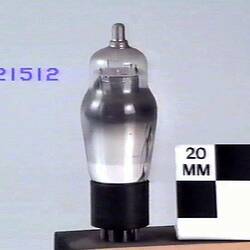Summary
Heptode or pentagrid converter, combined the functions of local oscillator and mixer in the one valve. The 6A8G is the same valve but fitted with an octal base. 6.3 volt indirectly heated cathode, manufactured by AWV, Sydney, Australia.
Domestic superheterodyne receivers in the early 1930s used a pentode as the frequency changer in the 'Autodyne' circuit where the one valve performed the function of local oscillator and mixer. This circuit was satisfactory for operation in the broadcast band but did not work at frequencies much above 2 MHz. Short wave receivers required a separate local oscillator valve. The introduction of the 6A7 in 1933 solved this problem and permitted the production of relatively simple dual wave radios without an extra valve.
Physical Description
Shouldered glass bulb with top cap on small 7 pin American style base.
More Information
-
Collection Names
-
Collecting Areas
-
Acquisition Information
Unknown Acquisition Method from Unknown Source, 1981
-
Manufacturer
Australian Wireless Valve Co (AWV Co), Sydney, New South Wales, Australia, 1936-1940
-
Inscriptions
Bulb: 6A7 Base: Radiotron/MADE IN AUSTRALIA/(illegible excise mark) paper label on base: 6A7
-
Brand Names
-
Classification
-
Category
-
Discipline
-
Type of item
-
Overall Dimensions
115 mm (Length), 38 mm (Outside Diameter)
-
Keywords

